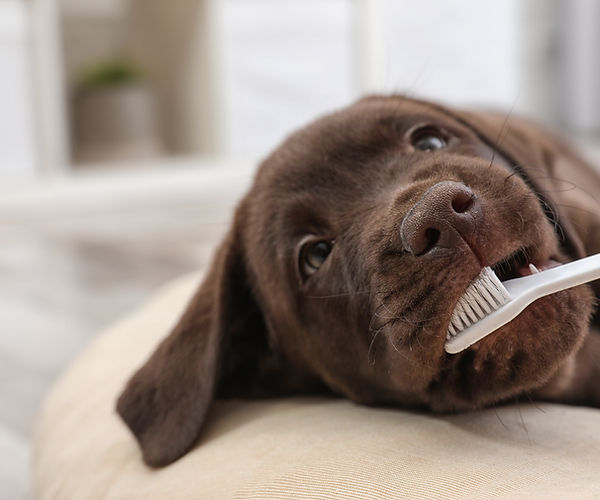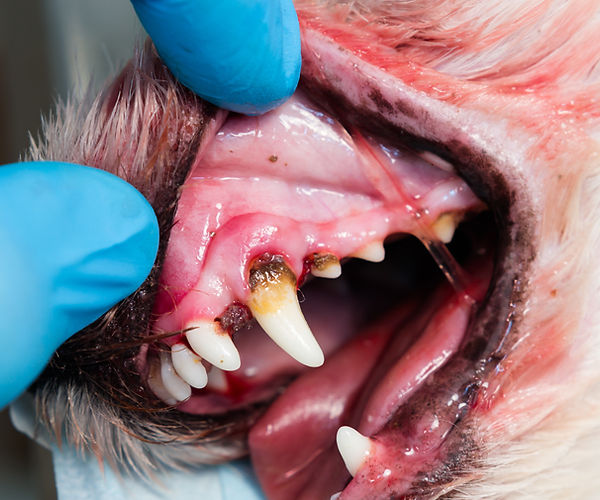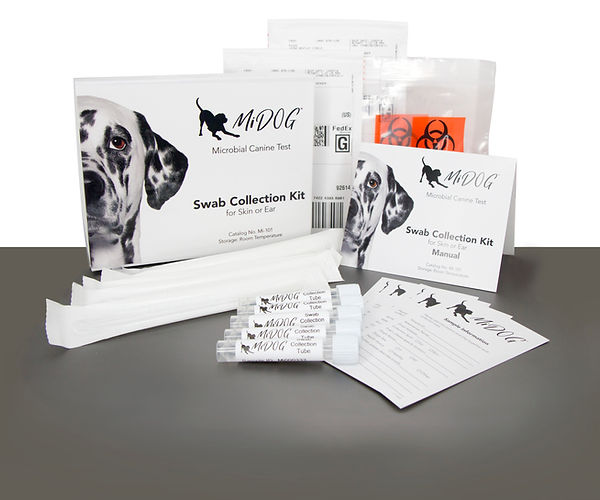
New MiDOG research characterizes the oral microbiome of healthy and disease-state dogs.
Cheese! Has your dog’s smile been looking inflamed? If so, your furry friend may have an infection and inflammation in the oral tissue surrounding and supporting their teeth. This condition is known as periodontitis and is caused by plaque, bacteria, and your dog’s immunologic response to these pathogens, which results in inflammation of the periodontal ligament and alveolar bone [1]. Although the etiology of periodontitis is complex, advancements in diagnostic technology have allowed for an increase in the efficacy of clinical interventions for canines [2]. Our team at MiDOG has collaborated with Dr. Brook Niemiec at Veterinary Dental Specialties and Oral Surgery in San Diego, CA, and Veterinary Clinic Arka in Krakow, Poland to produce groundbreaking research characterizing the bacteriome of the oral cavity in healthy dogs and dogs with periodontal disease.

Dr. Brook Niemiec is a Board Certified Specialist in Veterinary Dentistry of both the American and European Veterinary Dental Colleges.
This condition is painful for your dog and if left untreated can result in serious health complications and even death if the infection does not remain confined to your dog’s mouth. If you suspect your pet has periodontitis, it is recommended that you make an appointment with your veterinarian and determine the diagnostic tools they will be used to improve health outcomes!
Periodontitis Symptoms
As one of the most common oral diseases in canines, periodontitis impacts 44%-100% of canines [1]. That’s a lot! Notably, the prevalence and severity of this disease varies significantly based on dog size, breed, and more [1]. Periodontitis manifestation is multifaceted and initially occurs due to a polymicrobial infection caused by oral biofilm, which goes on to trigger an inflammatory immune response. Severe inflammation may lead to the destruction of connective tissue, alveolar bone, and periodontal ligament [3]. The bacteria in plaque that have historically been associated with periodontal disease include Bacteroides fragilis, Peptostreptococcus, Porphyromonas gulae, Porphyromonas salivosa, Poryphyromonas denticanis, Prevotella intermedia, Treponema spp., Bacteroides splanchicus, and more [3]. Consequently, plaque removal and control are particularly important in preventing periodontitis development [4]. Textured toys and food, daily teeth brushing, and fibrous items that allow the penetration of teeth help decrease the presence of plaque and biofilm [3].
Periodontal diseases occur in four distinct stages:

The image above depicts the stages of periodontitis.
Symptoms to look out for include but are not limited to:
- discolored teeth
- bad breath
- inflammation/bleeding in gums
- loose or missing teeth
- irritability
Periodontitis Treatment
If a patient is expressing signs of periodontitis, aggressive treatment is required. Once past the first stage (gingivitis) of infection, periodontitis is not easily reversible and extraction may be recommended [4]. Root scaling and planing may also be performed alongside the removal of infected/inflamed periodontal tissue [4]. Antibiotics that target the specific foreign bacteria that are causing the infection may be used as well [3]. If you suspect your dog has periodontitis, visit your veterinarian quickly; early intervention can save your dog’s teeth, quality of life, and potentially life.
To learn how to help prevent periodontitis, read this article.

The image above depicts the plaque formation and gum inflammation associated with periodontitis.
Advancements in Periodontitis Detection
To determine if a dog is impacted by periodontitis, veterinarians will often perform a conscious, visual exam to take note of the various signs of periodontal diseases, such as inflamed gums, plaque build-up, loose teeth, and more [5]. The presence and severity of these symptoms may indicate the need for a full workup, in which case the dog is anesthetized and full mouth intra-oral dental radiographs are performed [5]. One study evaluating the validity and reliability of a visual dental scale for detection of periodontal disease in non-anesthetized dogs found that while “an oral examination in an awake dog can be a helpful screening tool, it should not be considered a comprehensive evaluation of periodontal health” [5].
To optimize patient care and accurately identify the specific microbes affecting your dog’s oral health, scientists at MiDOG LLC created a new microbial DNA sequencing technology that identifies the presence and composition of microbes in patient samples. MiDOG’s sequencing technology has allowed for rapid identification of pathogenic microbes soon after the collection of your pet’s oral sample.
This has revolutionized the ability of veterinary medicine to accurately diagnose and treat canine periodontitis infections. In a collaborative case study led by scientists from MiDOG LLC and researchers from the Veterinary Dental Specialties and Oral Surgery and Veterinary Clinic Arka, the types of bacteria present in dogs without periodontal disease, or with mild, moderate, or severe periodontal disease were collected using sterile swabs in the maxillary arcade of each dog. These swabs were then submitted for next-generation sequencing (NGS) to compare the bacteriome of the oral cavity in healthy dogs and dogs with various stages of periodontal disease [6].
Establishing the Oral Microbiome of Clinically Healthy and Periodontitis Impacted Canines
Using MiDOG’s microbial DNA sequencing technology, the oral bacteriome of these canines were established.
The most abundant species were P. cangingivalis, Porphyromonas gulae, and an undefined Porphyromonas sp. Porphyromonas cangingivalis and Campylobacter sp. were part of the core microbiome shared among the 4 groups, and P. gulae, which was significantly enriched in dogs with severe periodontal disease, was part of the core microbiome shared between all groups except dogs without periodontal disease [6]. Christensenellaceae sp., Bacteroidales sp., Family XIII sp., Methanobrevibacter oralis, Peptostreptococcus canis, and Tannerella sp. formed a unique core microbiome in dogs with severe periodontal disease [6].
While a lot of these names sound weird, your veterinarian will know these pathogens and be able to help your dog’s infection! These results are clinically significant, because they highlight that potential pathogens can be common members of the oral cavity bacteriome in the absence of disease, and changes in the relative abundance of certain members of the bacteriome can be associated with the severity of periodontal disease in canines [6].
If all those bacterial names did not spook you yet, you can also read the full study here at AJVR.
How Does Your Veterinarian Detect Periodontitis?
The MiDOG All-in-One Microbial Test may provide the answer to the diagnostic conundrum that periodontitis poses. Utilizing NGS technology to detect and quantify all microbial DNA through untargeted and comprehensive sequencing and quantitative comparisons to reference databases, the MiDOG NGS technology provides a useful opportunity to shed light on the microbial makeup of your dog’s oral health for clinical application. The MiDOG microbiome test is a microbial identification test grounded on scientific research that provides veterinarians DNA evidence for the guided treatment of canine infections, such as periodontitis.

Find out if your vet uses MiDOG before you book your next appointment!
Citations:
[1] Wallis, C. and Holcombe, L., 2020. A review of the frequency and impact of periodontal disease in dogs. Journal of Small Animal Practice, 61(9), pp.529-540.
[2] Bauer, A., Stella, J., Lemmons, M. and Croney, C., 2018. Evaluating the validity and reliability of a visual dental scale for detection of periodontal disease (PD) in non-anesthetized dogs (Canis familiaris). PLOS ONE, 13(9), p.e0203930.
[3] Reiter, A., 2013. Periodontal Disease in Small Animals – Digestive System – MSD Veterinary Manual. [online] MSD Veterinary Manual. Available at: https://www.merckvetmanual.com/digestive-system/dentistry/periodontal-disease-in-small-animals.
[4] Özavci, V., Erbas, G., Parin, U., Yüksel, H. T., & Kirkan, Ş. (2019). Molecular detection of feline and canine periodontal pathogens. Veterinary and animal science, 8, 100069. https://doi.org/10.1016/j.vas.2019.100069
[5] Zhang, Y., Qi, Y., Lo, E., McGrath, C., Mei, M. L., & Dai, R. (2021). Using next-generation sequencing to detect oral microbiome change following periodontal interventions: A systematic review. Oral diseases, 27(5), 1073–1089. https://doi.org/10.1111/odi.13405
[6] Niemiec, B. A., Gawor, J., Tang, S., Prem, A., & Krumbeck, J. A. (2021). The bacteriome of the oral cavity in healthy dogs and dogs with periodontal disease. American journal of veterinary research, 83(1), 50–58. https://doi.org/10.2460/ajvr.21.02.0027
Categories: Dogs, Periodontal Disease, Pet Health, Safety and Wellness, Pet Parents

